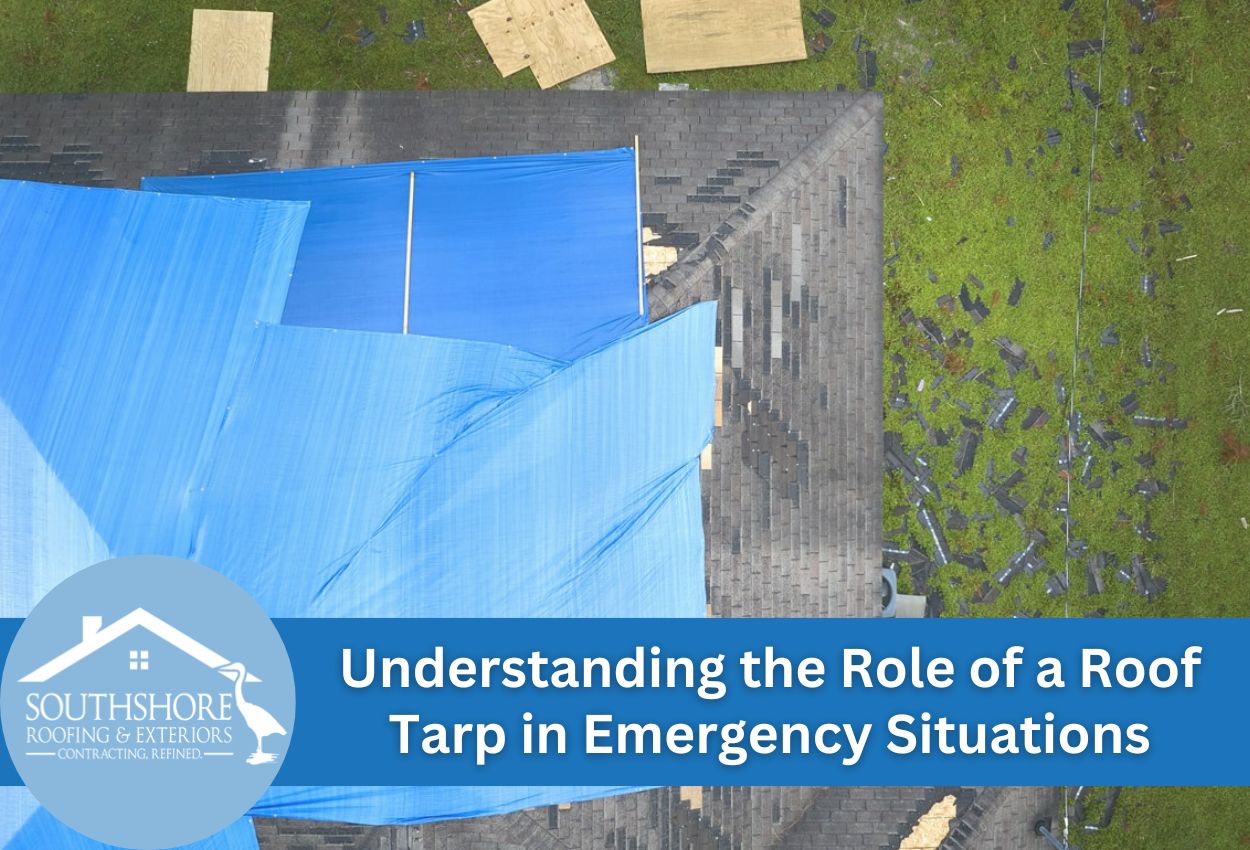When a storm hits and your roof suffers damage, the immediate concern is to prevent further harm to your home. A roof tarp serves as a crucial temporary protective measure, shielding your home from the elements and mitigating additional damage. The rapid application of a tarp is not just a recommended step, it’s essential for safeguarding your property from ongoing weather exposure and potential interior damage.
For homeowners, knowing how long a tarp can stay on a roof is vital during an emergency. Tarps are designed as a short-term solution while awaiting permanent repairs. Utilizing them correctly can prevent complications such as water leaks and structural weakening. In this section, we will explore how a tarp helps protect from additional damage and discuss tips for properly securing tarps to ensure they fulfill their role effectively.
Whether you’re dealing with the aftermath of a hurricane or preparing for seasonal storms, understanding the benefits of applying a tarp to a damaged roof as soon as possible and recognizing the importance of timely roof repair are crucial steps to maintaining the integrity of your home. Through practical tarp roof protection tips, this guide will equip you with the knowledge needed to handle emergency roofing situations confidently and efficiently.
Assessing the Durability of Roof Tarps
The effectiveness of a roof tarp largely depends on the materials used in its construction and their inherent weather-resistant properties. Most tarps are made from high-density polyethylene or PVC, which offers significant resistance to water and ultraviolet light. This resilience is crucial in areas like Tampa, FL, where frequent storms and intense sunlight can degrade materials quickly.
In Tampa, environmental factors such as high humidity, heavy rainfall, and strong UV rays can accelerate the wear and tear on roof tarps. Understanding how long a tarp can protect a structure in such conditions is essential for homeowners to plan for timely roof repairs. Typically, a well-installed tarp can last several months, but this duration can vary based on the severity of the weather conditions and the quality of the tarp installation.
To maximize the lifespan of a roof tarp and ensure it provides adequate protection, following tips for properly securing tarps is key. Secure attachment points, proper coverage, and regular inspections for damage can help extend the life of the tarp, ensuring it continues to protect your home until permanent repairs are made. Awareness of these factors will assist Tampa residents in maintaining their homes effectively in the face of future storms.
Proper Installation Techniques for Maximum Efficacy
Installing a roof tarp correctly is critical to ensure it provides the necessary protection against further damage to your home. A step-by-step guide on how to securely fasten a tarp to a roof can significantly aid in enhancing its effectiveness and durability. Initially, clear all debris and ensure the roof surface is as smooth as possible. Lay the tarp flat over the damaged area, extending it over the roof’s peak to ensure water runs off and doesn’t pool. Secure the tarp’s edges with 1-by-3 inch wood strips nailed through the tarp and into the roof framing.
Avoiding common mistakes is equally important to ensure that the tarp functions as intended. One typical error is failing to secure the tarp edges adequately, which can lead to wind lifting the tarp and allowing water to enter underneath. It’s also crucial to avoid placing nails directly through the tarp without wood strips, as this can tear the material and compromise the tarp’s waterproofing ability. Regular checks are advised to adjust the tarp as needed and to assess for potential wear and tear.
By understanding these proper installation techniques and common pitfalls, homeowners can effectively manage emergency situations with confidence. This knowledge not only helps protect the property but also extends the life of the tarp, ensuring that it remains an effective temporary solution until professional repairs are made.
The Lifespan of a Tarp on a Roof: Realistic Expectations
Understanding how long a tarp can stay on a roof is crucial for homeowners facing roof damage after a storm. Typically, a roof tarp is a temporary solution meant to offer immediate protection and can last anywhere from a few weeks to several months, depending on various factors. Being aware of this timeframe helps in planning for more permanent repairs to ensure the safety and integrity of the structure.
Several factors can influence the need for earlier replacement or removal of a roof tarp. These include the quality of the tarp material, the correctness of the installation, and exposure to environmental conditions. In regions like Tampa, FL, where storms and high winds are common, ensuring that a tarp is securely fastened and made of durable material is essential. Frequent inspections are advised to monitor for wear and tear and to replace the tarp if it shows signs of significant damage or deterioration.
Incorporating tarp roof protection tips and understanding the importance of timely roof repair are beneficial practices for maintaining a tarp’s effectiveness. By addressing damage promptly and ensuring that tarps are applied correctly, homeowners can protect their homes from further damage effectively.
Risks and Limitations of Prolonged Tarp Usage
While tarps are effective for temporary roof protection, extended use can lead to several potential issues. Prolonged exposure to the elements can degrade the material of the tarp, reducing its effectiveness in protecting the roof. This is particularly relevant in Tampa, FL, where the intense sun and frequent rain can accelerate the wear and tear on the tarp material. Additionally, long-term reliance on a tarp can also prevent the underlying structural issues from being addressed promptly, potentially leading to more severe damage.
Homeowners should be vigilant for signs that indicate the need to replace or remove the tarp. These signs include visible tears or holes in the tarp, frequent water leaks despite the tarp’s presence, and noticeable sagging or pooling of water on the tarp. Such issues suggest that the tarp is no longer providing adequate protection and may need immediate attention. Regular inspections and maintenance are crucial to ensuring that the tarp continues to serve its purpose effectively until permanent repairs can be implemented.
Transitioning from Temporary to Permanent Roof Solutions
Understanding when to shift from a temporary tarp to a permanent solution is crucial for maintaining the structural integrity of your home. Professional roof repair or replacement should be considered as soon as the tarp has been installed. Timely intervention is essential to prevent prolonged exposure to elements that can exacerbate the damage, leading to more complex and costly repairs. Engaging with a professional roofing contractor, especially in regions like Tampa, FL, where weather can be unpredictable, ensures that your roof is evaluated and treated correctly, minimizing risks of further damage.
The importance of timely intervention cannot be overstated. Delaying the transition from a tarp to permanent solutions not only threatens the safety of the dwelling but also the comfort and security of its occupants. Regular inspections and maintenance, guided by expert advice from roofing professionals, are key steps in ensuring that your roof remains robust and fully functional.
Essential Maintenance and Inspection Tips
Regular checks and maintenance of a roof tarp are crucial for ensuring it continues to provide optimal protection. To maintain a tarp effectively, it’s important to inspect it periodically for any signs of wear or damage, such as tears or loosening. Ensuring the tarp is securely fastened and free from pooling water can greatly extend its usability and effectiveness in protecting your roof.
In areas like Tampa, where weather conditions can be harsh, scheduling professional inspections can make a significant difference. Professionals can assess the integrity of the tarp and the roof structure underneath, advising on any necessary repairs or adjustments to maintain safety and protection. They understand the local climate’s impact on roofing materials and can provide tailored advice on prolonging the life of a tarp and ensuring it offers the best protection possible.
By following these essential maintenance and inspection tips, homeowners can feel confident that their temporary roof solutions are not just in place but actively working to protect their homes from further damage. Engaging with local Tampa professionals ensures that the specific challenges of the region are addressed, maintaining the effectiveness of the tarp as long as it is needed.
Protect Your Home with SouthShore Roofing & Exteriors
Don’t wait for further damage! Call SouthShore Roofing & Exteriors at (813) 400-3329 for expert tarp installation and secure your damaged roof today. Our team understands the significance of timely protection. Act now to prevent structural damage and costly repairs. With our durable tarp solutions, your home will be safeguarded from environmental factors in Tampa, FL. Trust SouthShore Roofing & Exteriors for reliable, weather-resistant tarp installations and permanent roof solutions. Schedule a professional inspection and ensure continued protection for your home. Contact us today!




